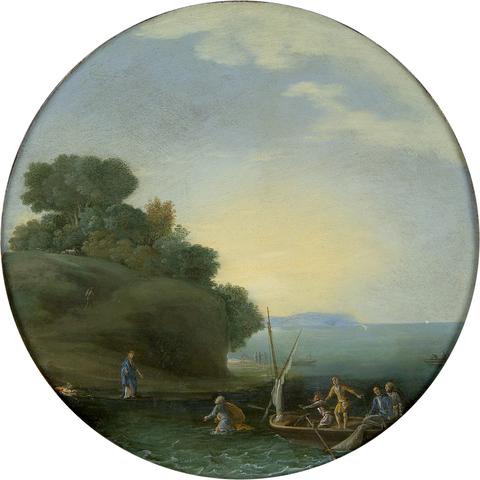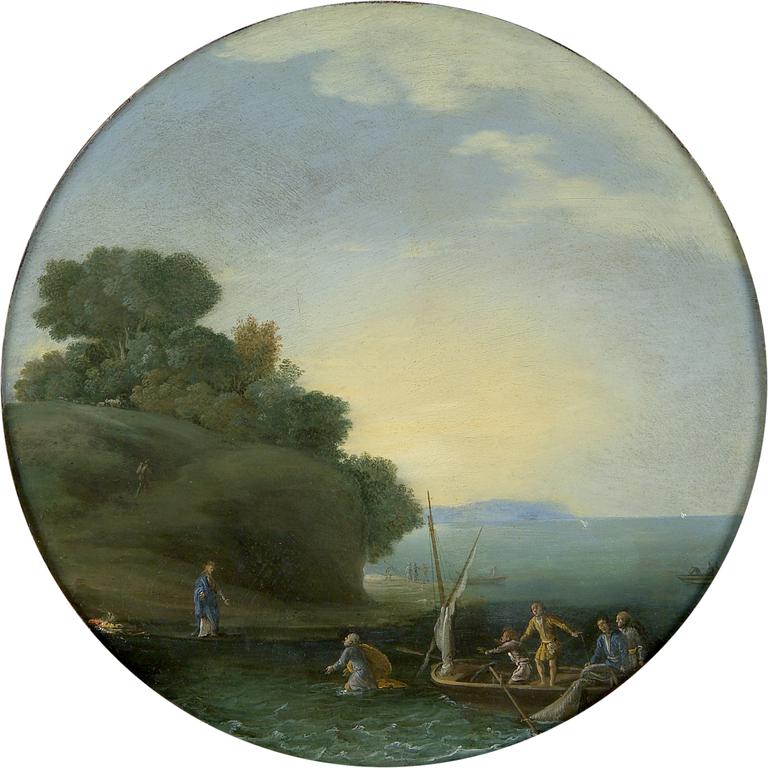
L’Apparition du Christ au lac de Tibériade
Goffredo Wals (vers 1590 Cologne - vers 1640 Calabre)
1620 (vers)
Huile sur cuivre ; 22,7 cm
Provenance :
Londres, Christie’s, 22 avril 1994 ; Allemagne, collection privée ; Londres, Sotheby’s, 27 octobre 2011 ; Paris, collection Le Polyptyque ; Paris, collection privée.
Bibliographie :
Marcel G. Roethlisberger, From Goffredo Wals to the beginnings of Claude Lorrain, Artibus et Historiae, vol. 32, 1995.
Dans son article de 1995, Marcel G. Roethlisberger, le meilleur spécialiste de la question, donnait cette œuvre à Goffredo Wals. Réapparue en 2011 dans une vente décrite dans un blog comme « un jeu de massacre démontrant les effets de la crise sur le marché de l’art », elle n’était plus attribuée qu’à « l’entourage » de Wals. Cette hésitation s’explique. Wals, redécouvert en 1969 seulement, est encore mal connu. Né à Cologne, il est de ces artistes qui cherchaient en Italie l’inspiration ou la commande et quelquefois, s’y installaient. Il vécut à Naples essentiellement, mais aussi à Rome de 1616 à 1618, et à Gênes de 1630 à 1632.
Marcel G. Roethlisberger notait déjà une délinéation des formes, une présence des personnages plus achevées que d’ordinaire chez ce peintre dont la personnalité stylistique s’est précisée, depuis, dans le sens d’un minimalisme, parfois d’une sécheresse, que l’on ne retrouve pas ici où l’eau, la verdure et le soleil s’éploient. Or que sait-on de « l’entourage » de Wals ? À Rome, de 1616 à 1618, il travailla dans l’atelier d’Agostino Tassi. À Naples, de 1620 à 1622, c’est Claude Lorrain qui travailla dans son atelier ; puis, de retour à Rome de 1622 à 1625, dans celui de Tassi. C’est à l’intérieur de ce triangle que se situe notre tableau, plutôt dans l’angle du Lorrain : la lueur, le feuillage par endroits doré, le berger sur la pente et son troupeau à la lisière du bosquet…
On ne sait rien aujourd’hui de sa production avant 1627 et son retour à Rome, après un bref aller-retour en Lorraine. Mais dans un tableau (Suisse, collection privée) datable de 1625-1627, et considéré comme du Lorrain, pour l’architecture et le paysage, et de Tassi, pour les personnages, on retrouve la « cascade » d’arbres, tombant de la gauche, une mer étale, mais animée de vaguelettes au premier plan, et les personnages filiformes du second plan. Remarquons à ce propos le feu allumé sur la rive. Il rappelle la Scène de sorcellerie du même Tassi de 1625-1626 (Baltimore, Walters Art Museum). Il précise aussi l’épisode représenté : non pas, comme on l’a écrit jusqu’ici, la vocation de saint Pierre, mais l’apparition du Christ au lac de Tibériade.
Cette lueur, c’est donc l’aurore : l’Aurore qu’avait peinte Elsheimer, à Rome en 1606, sur un petit tableau sur cuivre (Braunschweig, Herzog Anton Ulrich Museum) qui révolutionna la peinture de paysage. L’aurore, peut-être, d’une œuvre, celle de Claude Lorrain, qui trouva son zénith en 1656 dans un autre paysage de Terre Sainte avec aussi, en fond, le lac de Tibériade : le Sermon sur la Montagne (New York, Frick Collection).
